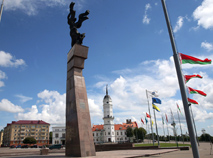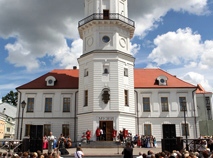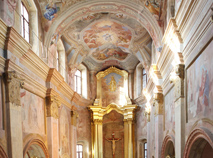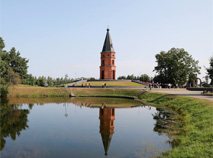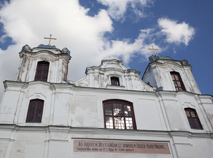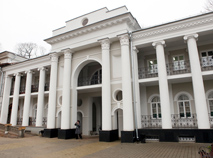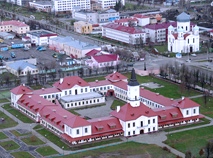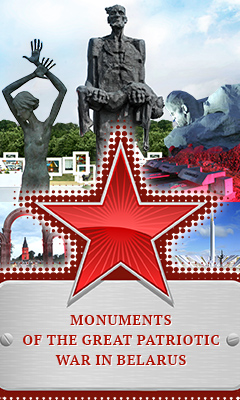Mogilev Oblast Landmarks

The famous trade route from the Varangians to the Greeks passed through the eastern lands of Belarus centuries ago. The Dnieper, one of Europe’s biggest rivers, was part of this route. Several towns sprung up along the route in the 12th-13th centuries. Among them are Mstislavl (1135), Krichev and Propoisk (Slavgorod) (1136), and Mogilev (1267)… Later on Mogilev Province was greatly fancied by Russian emperors: Catherine the Great gifted local mansions to her favorites, and Nicholas II ordered to set up the General Headquarters in Mogilev during the First World War. The places of interest of the region include wonderful architectural monuments of Mogilev that survived from the imperial times, the 17th-century castle and the unique synagogue in Bykhov, the palace and park ensemble in Zhilichi, Potemkin’s Palace in Krichev, the Holy Assumption Monastery in Pustynki, the ancient Mstislavl, Bobruisk Fortress…
Mogilev
 The city was established on the bank of the Dnieper River more than seven centuries ago. If you look at the map of Belarus, you will not be surprised why Mogilev has been used as a strategic location many times over its history. During the First World War the Russian Army Headquarters and the residence of Emperor Nicholas II were located there. Before the Second World War, there were plans to relocate Belarus’ capital to Mogilev, because Minsk was too close to the country’s western border. A testimony to that was the hasty construction of the House of Soviets in Mogilev. The building was nearly the exact replica of the Minsk-based House of Government. During the Great Patriotic War Mogilev held out against the enemy for 23 days, including 16 days in complete encirclement.
The city was established on the bank of the Dnieper River more than seven centuries ago. If you look at the map of Belarus, you will not be surprised why Mogilev has been used as a strategic location many times over its history. During the First World War the Russian Army Headquarters and the residence of Emperor Nicholas II were located there. Before the Second World War, there were plans to relocate Belarus’ capital to Mogilev, because Minsk was too close to the country’s western border. A testimony to that was the hasty construction of the House of Soviets in Mogilev. The building was nearly the exact replica of the Minsk-based House of Government. During the Great Patriotic War Mogilev held out against the enemy for 23 days, including 16 days in complete encirclement.
 Today visitors to the city are welcomed by the sculpture of a railway station inspector erected near the old railway station (1902). The air of history can be felt in the pedestrian Lenin Street that has been known since the 16th century under various names, like Vetryanaya Street, Bolshaya Sadovaya Street and Inzhenernaya Street. Here one can see beautiful buildings dating back to the 18th-19th centuries: the former municipal administration building, the palace of the archbishop, the gymnasium which famous students included the First Hawaii Senate President Nikolai Sudzilovsky and a celebrated explorer of the Arctic Otto Schmidt… The street is divided by the Square of Stars featuring the world’s only monument to the stargazer and the sundial consisting of 12 chairs symbolizing the Zodiac signs.
Today visitors to the city are welcomed by the sculpture of a railway station inspector erected near the old railway station (1902). The air of history can be felt in the pedestrian Lenin Street that has been known since the 16th century under various names, like Vetryanaya Street, Bolshaya Sadovaya Street and Inzhenernaya Street. Here one can see beautiful buildings dating back to the 18th-19th centuries: the former municipal administration building, the palace of the archbishop, the gymnasium which famous students included the First Hawaii Senate President Nikolai Sudzilovsky and a celebrated explorer of the Arctic Otto Schmidt… The street is divided by the Square of Stars featuring the world’s only monument to the stargazer and the sundial consisting of 12 chairs symbolizing the Zodiac signs.
![]() On top of the restored Mogilev City Hall you will see a breathtaking panorama of the city and hear the trumpet player who plays the fanfare three times a day and tells stories about the history of Mogilev.
On top of the restored Mogilev City Hall you will see a breathtaking panorama of the city and hear the trumpet player who plays the fanfare three times a day and tells stories about the history of Mogilev.
![]() 200km from Minsk
200km from Minsk
Mogilev Drama Theater
 The original building of the Mogilev Drama Theater was the first in Belarus to be constructed specifically for a theater company. Before that performances were staged in the palaces of wealthy landlords and in pavilions of traveling theaters. Back in the 1810s the local residents dreamt of a permanent theater, but their dream came true several decades later. The theater was designed by architect Piotr Kamburov. It was built from red brick in the pseudo-Russian style on the place of a 17th-century castle. The theater was solemnly inaugurated on 25 September 1888. It boasted one of Europe’s best stages in terms of sound. Among the celebrated artists who performed at the theater were opera singer Fyodor Shalyapin, virtuoso Sergei Rakhmaninov, and actress Vera Komissarzhevskaya. It was there that Emperor Nicholas II watched wartime newsreel and reviewed the troops during the First World War from the balcony.
The original building of the Mogilev Drama Theater was the first in Belarus to be constructed specifically for a theater company. Before that performances were staged in the palaces of wealthy landlords and in pavilions of traveling theaters. Back in the 1810s the local residents dreamt of a permanent theater, but their dream came true several decades later. The theater was designed by architect Piotr Kamburov. It was built from red brick in the pseudo-Russian style on the place of a 17th-century castle. The theater was solemnly inaugurated on 25 September 1888. It boasted one of Europe’s best stages in terms of sound. Among the celebrated artists who performed at the theater were opera singer Fyodor Shalyapin, virtuoso Sergei Rakhmaninov, and actress Vera Komissarzhevskaya. It was there that Emperor Nicholas II watched wartime newsreel and reviewed the troops during the First World War from the balcony.
![]() At the entrance to the theater there is a bronze statue Lady with a Dog, a copy of the famous sculpture by Belarusian sculptor Vladimir Zhbanov that can be seen on the Komarovka Market in Minsk.
At the entrance to the theater there is a bronze statue Lady with a Dog, a copy of the famous sculpture by Belarusian sculptor Vladimir Zhbanov that can be seen on the Komarovka Market in Minsk.
![]() 7 Pervomaiskaya Street, Mogilev
7 Pervomaiskaya Street, Mogilev
Cathedral of Three Saints in Mogilev
 Mogilev’s major Eastern Orthodox cathedral, an architectural specimen of the early 20th century, was named after Basil the Great, Gregory the Theologian, and John Chrysostom. The seven-dome cathedral was built in the form of a cross in the pseudo-Russian style. It has a very remarkable feature: one can enter it from three sides. During the First World War the cathedral was frequented by Emperor Nicholas II. The major halidom of the church is the replica of the wonder-working Icon of the Mother of God of Mogilev and Bratsk. The church also holds the icon of Saint Nicholas with pieces of hallows, the replicas of the Belynichi and Barkolabovo icons of the Mother of God, and the image of Saint Euphrosyne of Polotsk dating back to 1910.
Mogilev’s major Eastern Orthodox cathedral, an architectural specimen of the early 20th century, was named after Basil the Great, Gregory the Theologian, and John Chrysostom. The seven-dome cathedral was built in the form of a cross in the pseudo-Russian style. It has a very remarkable feature: one can enter it from three sides. During the First World War the cathedral was frequented by Emperor Nicholas II. The major halidom of the church is the replica of the wonder-working Icon of the Mother of God of Mogilev and Bratsk. The church also holds the icon of Saint Nicholas with pieces of hallows, the replicas of the Belynichi and Barkolabovo icons of the Mother of God, and the image of Saint Euphrosyne of Polotsk dating back to 1910.
![]() 7 Pervomaiskaya Street, Mogilev
7 Pervomaiskaya Street, Mogilev
St. Stanislaus Cathedral
 A beautiful Baroque-style Roman Catholic Church of the Assumption of the Blessed Virgin Mary was built in Mogilev on the site of the Carmelite monastery. A legend says that it was built from kiln bricks that were brought by the townspeople to atone for the sin of the murder of a local nobleman. After visiting the temple in 1780 Empress Catherine II ordered to evict the monks and to convert the church into a cathedral. At the end of the 18th century it was reconstructed in the Classicism style and received a second name in honor of St. Stanislaus. The domes of the cathedral are decorated with the unique authentic 18th-century frescoes to the Bible stories representing one of the most complete and professional Evangelical cycles in Belarus.
A beautiful Baroque-style Roman Catholic Church of the Assumption of the Blessed Virgin Mary was built in Mogilev on the site of the Carmelite monastery. A legend says that it was built from kiln bricks that were brought by the townspeople to atone for the sin of the murder of a local nobleman. After visiting the temple in 1780 Empress Catherine II ordered to evict the monks and to convert the church into a cathedral. At the end of the 18th century it was reconstructed in the Classicism style and received a second name in honor of St. Stanislaus. The domes of the cathedral are decorated with the unique authentic 18th-century frescoes to the Bible stories representing one of the most complete and professional Evangelical cycles in Belarus.
![]() Unfortunately, the unique organ of the cathedral was destroyed. According to a legend, it was listed as No. 2 at the Vatican. Today the cathedral hosts concerts of the International Festival of Church Music Mighty God.
Unfortunately, the unique organ of the cathedral was destroyed. According to a legend, it was listed as No. 2 at the Vatican. Today the cathedral hosts concerts of the International Festival of Church Music Mighty God.
![]() 4 Komsomolskaya Street, Mogilev
4 Komsomolskaya Street, Mogilev
St. Nicholas Monastery
 St. Nicholas Monastery is one of the few surviving buildings in the Belarusian Baroque style. The monastery, which is part of the UNESCO World Heritage tentative list, includes St. Nicholas Cathedral (among the most valuable Baroque buildings in Europe), the Temple of St. Onuphrius the Great, a belfry, and living quarters. The pride of St. Nicholas Church is a beautiful four-tier iconostasis made by skilled Mogilev carvers in the 17th century, among whom was Klim Mikhailov, a native of Shklov. He is famous for his work on the Tsar Palace in Kolomenskoye and on the chambers of the Kremlin. Similar iconostasis can be seen only in the Smolensk Cathedral of the Novodevichy Convent in Moscow.
St. Nicholas Monastery is one of the few surviving buildings in the Belarusian Baroque style. The monastery, which is part of the UNESCO World Heritage tentative list, includes St. Nicholas Cathedral (among the most valuable Baroque buildings in Europe), the Temple of St. Onuphrius the Great, a belfry, and living quarters. The pride of St. Nicholas Church is a beautiful four-tier iconostasis made by skilled Mogilev carvers in the 17th century, among whom was Klim Mikhailov, a native of Shklov. He is famous for his work on the Tsar Palace in Kolomenskoye and on the chambers of the Kremlin. Similar iconostasis can be seen only in the Smolensk Cathedral of the Novodevichy Convent in Moscow.
![]() St. Nicholas Church was often visited by the last Russian Emperor Nicholas II. One of the monastery novitiates was False Dmitry II.
St. Nicholas Church was often visited by the last Russian Emperor Nicholas II. One of the monastery novitiates was False Dmitry II.
![]() 19 T. Surty Street, Mogilev
19 T. Surty Street, Mogilev
Residence of Archbishop Georgy Konissky
 The Palace of Archbishop Georgy Konissky, a prominent Eastern Orthodox Church hierarchs, scholar and educator, Belarus’ saint, was erected by architect Johann Glaubitz in 1762-1785. The ancient residence still remains one of the landmarks of Mogilev. Many of its elements such as niches, window cases with intricate patterns and floral motifs, give the palace Baroque-style looks. In the past there were monastic cells on both sides of the building; and the drawings on their walls made a complete ensemble of the whole compound. The large hall on the ground floor hosted receptions. The upper tier housed personal living quarters, an office and a library of the Archbishop.
The Palace of Archbishop Georgy Konissky, a prominent Eastern Orthodox Church hierarchs, scholar and educator, Belarus’ saint, was erected by architect Johann Glaubitz in 1762-1785. The ancient residence still remains one of the landmarks of Mogilev. Many of its elements such as niches, window cases with intricate patterns and floral motifs, give the palace Baroque-style looks. In the past there were monastic cells on both sides of the building; and the drawings on their walls made a complete ensemble of the whole compound. The large hall on the ground floor hosted receptions. The upper tier housed personal living quarters, an office and a library of the Archbishop.
![]() 1 Konissky’s Archiereisky Val, Mogilev
1 Konissky’s Archiereisky Val, Mogilev
Vitold Belynitsky-Birulya Art Museum of Mogilev
 The museum of outstanding Belarusian landscape painter Vitold Belynitsky-Birulya whose works were admired by Ilya Repin features a big collection of the painter’s works. The artist’s home that was located not far from the city did not survive to the present day. The museum, a subsidiary of the National Art Museum of Belarus, was opened at a 17th century estate. Its holdings include documents, photos of the artist and his family, the artist’s personal things: the painting box, the palette, brushes, the sporting gun… The museum keeps the medal received for the famous Winter Dream at the exhibition in Barcelona (1911). There is also a cycle of paintings dedicated to Pushkin places: "Mikhailovskoye. House of Alexander Pushkin’s nurse Arina Rodionovna", "Svyatogorsk Monastery. Alexander Pushkin’s Tomb", "Trigorskoye. A birch by the Sorot River" …
The museum of outstanding Belarusian landscape painter Vitold Belynitsky-Birulya whose works were admired by Ilya Repin features a big collection of the painter’s works. The artist’s home that was located not far from the city did not survive to the present day. The museum, a subsidiary of the National Art Museum of Belarus, was opened at a 17th century estate. Its holdings include documents, photos of the artist and his family, the artist’s personal things: the painting box, the palette, brushes, the sporting gun… The museum keeps the medal received for the famous Winter Dream at the exhibition in Barcelona (1911). There is also a cycle of paintings dedicated to Pushkin places: "Mikhailovskoye. House of Alexander Pushkin’s nurse Arina Rodionovna", "Svyatogorsk Monastery. Alexander Pushkin’s Tomb", "Trigorskoye. A birch by the Sorot River" …
![]() 37 Leninskaya Street, Mogilev
37 Leninskaya Street, Mogilev
Mogilev Art Museum
 The Mogilev Regional Art Museum named after Pavel Maslenikov is not only a guardian of masterpieces of the 17th-19th centuries but also a great architectural specimen. The building of the farmers’ land bank which once housed museums and newspaper offices was built in 1903–1914. The project harmoniously combined modern, Neo-Russian style and late Classicism. The main point of interest in the building was an armor-plated strong room that kept unique valuables, many of which disappeared tracklessly during the Great Patriotic War: the Cross of Euphrosyne of Polotsk (the museum exhibits a hologram of the relic), the Pompeii gold, Alexander of Macedon’s tray, paintings of European artists, hand-written books and documents, coins and icons of the 17th-19th centuries…
The Mogilev Regional Art Museum named after Pavel Maslenikov is not only a guardian of masterpieces of the 17th-19th centuries but also a great architectural specimen. The building of the farmers’ land bank which once housed museums and newspaper offices was built in 1903–1914. The project harmoniously combined modern, Neo-Russian style and late Classicism. The main point of interest in the building was an armor-plated strong room that kept unique valuables, many of which disappeared tracklessly during the Great Patriotic War: the Cross of Euphrosyne of Polotsk (the museum exhibits a hologram of the relic), the Pompeii gold, Alexander of Macedon’s tray, paintings of European artists, hand-written books and documents, coins and icons of the 17th-19th centuries…
![]() The image of the museum is depicted on the Br200,000 banknote.
The image of the museum is depicted on the Br200,000 banknote.
![]() 33 Mironova Street, Mogilev
33 Mironova Street, Mogilev ![]() 10.00 to 18.00. Closed: Monday, Tuesday
10.00 to 18.00. Closed: Monday, Tuesday
Buinichi Field Memorial
 The memorial commemorates the soldiers who defended the city against the Nazis for 23 days in July 1941. The heroism of the soldiers is one of the brightest pages of the Great Patriotic War. Mogilev is often called "the Father of Stalingrad". The memorial has a red chapel featuring memorial tablets with the names of the killed defenders. There is also the Foucault pendulum, a symbol of imperishable memory, at the memorial. Four alleys radiate from the chapel, with one dedicated to the first chronicler of the Mogilev defense, author of the Alive and the Dead novel Konstantin Simonov. Nearby is an open-air exposition of military hardware.
The memorial commemorates the soldiers who defended the city against the Nazis for 23 days in July 1941. The heroism of the soldiers is one of the brightest pages of the Great Patriotic War. Mogilev is often called "the Father of Stalingrad". The memorial has a red chapel featuring memorial tablets with the names of the killed defenders. There is also the Foucault pendulum, a symbol of imperishable memory, at the memorial. Four alleys radiate from the chapel, with one dedicated to the first chronicler of the Mogilev defense, author of the Alive and the Dead novel Konstantin Simonov. Nearby is an open-air exposition of military hardware.
![]() Not far away from the chapel is the Lake of Tears, representing the suffering of all the mothers who lost their children during the war.
Not far away from the chapel is the Lake of Tears, representing the suffering of all the mothers who lost their children during the war.
![]() Buinichi village, Mogilev District, 3km away from Mogilev
Buinichi village, Mogilev District, 3km away from Mogilev
Bykhov Castle
 An outstanding architectural specimen, Bykhov Castle is a landmark of the ancient town. The castle was erected by Hetman of the Grand Duchy of Lithuania Jan Karol Chodkiewicz. The citadel was surrounded by earth mounds and a moat and was guarded by defensive towers. Inside the defensive walls was a grand castle complex with private chambers and a magnificent crown hall for official meetings, receptions and balls. In 1628 the castle was purchased by Lew Sapieha who ordered large-scale renovations of the castle. Throughout its history the castle witnessed many wars. Fragments of the castle have survived till today. The only surviving fortress-town of the 17th century in Belarus is currently being renovated.
An outstanding architectural specimen, Bykhov Castle is a landmark of the ancient town. The castle was erected by Hetman of the Grand Duchy of Lithuania Jan Karol Chodkiewicz. The citadel was surrounded by earth mounds and a moat and was guarded by defensive towers. Inside the defensive walls was a grand castle complex with private chambers and a magnificent crown hall for official meetings, receptions and balls. In 1628 the castle was purchased by Lew Sapieha who ordered large-scale renovations of the castle. Throughout its history the castle witnessed many wars. Fragments of the castle have survived till today. The only surviving fortress-town of the 17th century in Belarus is currently being renovated.
![]() Other landmarks of Bykhov are the ancient Holy Trinity Church and the unique defensive synagogue of the 17th century.
Other landmarks of Bykhov are the ancient Holy Trinity Church and the unique defensive synagogue of the 17th century.
![]() Bykhov
Bykhov
Park and Palace Complex in Zhilichi
 In the 19th century the Park and Palace Complex in Zhilichi was one of the most famous and luxurious estates alongside the castles in Nesvizh and Mir. The palace belonged to nobleman Ignaty Bulgak. After 50 years of construction, the castle was inherited by his son Edgar. The castle’s interiors amazed its guests by the molding on the walls and ceilings, numerous wooden decorations and mirrors, a secret chamber for musicians who entertained guests on balconies. The castle was proud of the Louis XVI style furniture, valuable paintings and a unique collection of ancient sculptures, famous Slutsk belts, an excellent library... Apart from that, the castle complex had a greenhouse with tropical plants and an amazing park with sculptures, pavilions, and water basins…
In the 19th century the Park and Palace Complex in Zhilichi was one of the most famous and luxurious estates alongside the castles in Nesvizh and Mir. The palace belonged to nobleman Ignaty Bulgak. After 50 years of construction, the castle was inherited by his son Edgar. The castle’s interiors amazed its guests by the molding on the walls and ceilings, numerous wooden decorations and mirrors, a secret chamber for musicians who entertained guests on balconies. The castle was proud of the Louis XVI style furniture, valuable paintings and a unique collection of ancient sculptures, famous Slutsk belts, an excellent library... Apart from that, the castle complex had a greenhouse with tropical plants and an amazing park with sculptures, pavilions, and water basins…
![]() Zhilichi Castle is being restored. Its premises house an art school. In the future the castle will have a museum, a library, an art gallery, a greenhouse, and a small hotel.
Zhilichi Castle is being restored. Its premises house an art school. In the future the castle will have a museum, a library, an art gallery, a greenhouse, and a small hotel.
![]() Village of Zhilichi, Kirovsk District, 114km away from Mogilev, 169km away from Minsk
Village of Zhilichi, Kirovsk District, 114km away from Mogilev, 169km away from Minsk
Bobruisk
 The town of Bobruisk is one of the biggest and oldest towns in Belarus. It is also a ‘literature celebrity’. Characters of the novel The Little Golden Calf by Ilf and Petrov called it "a wonderful, highly cultured place". By the way, the sculpture featuring one of the novel’s characters Shura Balaganov was unveiled near the Red Tower (1927). Centuries ago Bobruisk was famous for traditional crafts and beaver hunt. The town derives its name from the Russian word ‘bobr’ meaning beaver. The town has a modern popular symbol – the Beaver monument. They say that to be wealthy and successful one needs to rub a watch chain on his big paunch. Bobruisk has the architecture of the Jewish town of the 19th – early 20th centuries. The most impressive buildings in the town are the Katsnelson house, ancient synagogues, St. Nicholas Church (1892-1894), the Church of the Virgin Mary (1901)…
The town of Bobruisk is one of the biggest and oldest towns in Belarus. It is also a ‘literature celebrity’. Characters of the novel The Little Golden Calf by Ilf and Petrov called it "a wonderful, highly cultured place". By the way, the sculpture featuring one of the novel’s characters Shura Balaganov was unveiled near the Red Tower (1927). Centuries ago Bobruisk was famous for traditional crafts and beaver hunt. The town derives its name from the Russian word ‘bobr’ meaning beaver. The town has a modern popular symbol – the Beaver monument. They say that to be wealthy and successful one needs to rub a watch chain on his big paunch. Bobruisk has the architecture of the Jewish town of the 19th – early 20th centuries. The most impressive buildings in the town are the Katsnelson house, ancient synagogues, St. Nicholas Church (1892-1894), the Church of the Virgin Mary (1901)…
![]() One of the major monuments of the Belarusian military history, the Bobruisk Fortress, is located in the town. The construction of the fortress was launched in 1810.
One of the major monuments of the Belarusian military history, the Bobruisk Fortress, is located in the town. The construction of the fortress was launched in 1810.
![]() 111km away from Mogilev, 145km away from Minsk
111km away from Mogilev, 145km away from Minsk
Bobruisk Fortress
 Bobruisk Fortress, one of the best equipped fortresses in Europe, left its mark in the history due to the events of the War of 1812, the Decembrist Revolt, and the Great Patriotic War. It became famous not only for its fortifications but also for its splendid Classicism-style architecture. During the War of 1812 the military post suffered the brunt of Napoleon's offensive. After the Russian army's retreat it resisted the siege pressed by the French for four months. Within these very walls Decembrists Sergei Muravyov-Apostol and Mikhail Bestuzhev-Ryumin developed the legendary Bobruisk Plan to capture the fortress and overthrow Alexander I.
Bobruisk Fortress, one of the best equipped fortresses in Europe, left its mark in the history due to the events of the War of 1812, the Decembrist Revolt, and the Great Patriotic War. It became famous not only for its fortifications but also for its splendid Classicism-style architecture. During the War of 1812 the military post suffered the brunt of Napoleon's offensive. After the Russian army's retreat it resisted the siege pressed by the French for four months. Within these very walls Decembrists Sergei Muravyov-Apostol and Mikhail Bestuzhev-Ryumin developed the legendary Bobruisk Plan to capture the fortress and overthrow Alexander I.
![]() Bobruisk
Bobruisk
Osipovichi
 One of the largest railway junctions in Belarus was built as part of the Libau-Romny Railway in the late 19th century. It was not by chance that a steam train became part of the town’s history and was depicted on its coat of arms. In 2002 a real old steam train that used to be operated by the railway service was placed on a plinth near the station. Other Osipovichi’s landmarks include the building of the railway station, the old water tower, the buildings constructed in late 19th and early 20th centuries, and the masterpiece of wooden architecture Eastern Orthodox Church of the Exaltation of the Holy Cross erected in the village of Zborsk in 1826 and relocated to Osipovichi in 1946.
One of the largest railway junctions in Belarus was built as part of the Libau-Romny Railway in the late 19th century. It was not by chance that a steam train became part of the town’s history and was depicted on its coat of arms. In 2002 a real old steam train that used to be operated by the railway service was placed on a plinth near the station. Other Osipovichi’s landmarks include the building of the railway station, the old water tower, the buildings constructed in late 19th and early 20th centuries, and the masterpiece of wooden architecture Eastern Orthodox Church of the Exaltation of the Holy Cross erected in the village of Zborsk in 1826 and relocated to Osipovichi in 1946.
![]() 160km away from Mogilev, 108km away from Minsk
160km away from Mogilev, 108km away from Minsk
Shklov
 Belarus’ "Cucumber Capital" boasts rich harvests of this vegetable. Local people have been growing cucumbers since the 16th century. Now they celebrate the Cucumber Day every year in August. The main town square features the sculptural composition Cucumber and the monument to Semyon Zorich, the famous favorite of Russian Empress Catherine II who founded a school for noble children, a ballet school, and a music school, and built a magnificent palace, an enormous greenhouse for holding balls and masquerades, and the Transfiguration Church in Shklov. Today the building of the Town Hall dating back to the late 18th century and constructed together with the market is the main landmark of the town. Its high faceted tower is decorated with an old clock, and the spire is topped with the coat of arms of the town.
Belarus’ "Cucumber Capital" boasts rich harvests of this vegetable. Local people have been growing cucumbers since the 16th century. Now they celebrate the Cucumber Day every year in August. The main town square features the sculptural composition Cucumber and the monument to Semyon Zorich, the famous favorite of Russian Empress Catherine II who founded a school for noble children, a ballet school, and a music school, and built a magnificent palace, an enormous greenhouse for holding balls and masquerades, and the Transfiguration Church in Shklov. Today the building of the Town Hall dating back to the late 18th century and constructed together with the market is the main landmark of the town. Its high faceted tower is decorated with an old clock, and the spire is topped with the coat of arms of the town.
![]() Archaeologists unearthed the "lost" old town with a castle near the bend of the Dnieper River on the outskirts of the present-day Shklov. They continue discovering new historical layers and astounding archaeological finds, such as the observation tower and the house of the owner of the castle, the ruins of the Resurrection Church and the Dominican Monastery, and many 17th-century artifacts.
Archaeologists unearthed the "lost" old town with a castle near the bend of the Dnieper River on the outskirts of the present-day Shklov. They continue discovering new historical layers and astounding archaeological finds, such as the observation tower and the house of the owner of the castle, the ruins of the Resurrection Church and the Dominican Monastery, and many 17th-century artifacts.
![]() 35km to the north of Mogilev, 244km away from Minsk
35km to the north of Mogilev, 244km away from Minsk
Gorki
 The town on the bank of the Pronya River has been famous for its fairs since ancient times. Merchants from different countries used to gather in Gorki for those fairs three times a year. However, the Golden Age of the town was the 19th century when the Gory-Gorki Agricultural School, the first higher educational establishment of the kind in the country, was founded on the order of Russian Emperor Nicholas I. The Belarusian State Agricultural Academy in Gorki is currently one of the oldest and largest agricultural universities in Europe. Today the visitors can see its main building erected by the famous Italian architect Angelo Campioni in 1840 and the oldest botanical garden and arboretum in Belarus with the largest collection of plants from different eco-geographical zones.
The town on the bank of the Pronya River has been famous for its fairs since ancient times. Merchants from different countries used to gather in Gorki for those fairs three times a year. However, the Golden Age of the town was the 19th century when the Gory-Gorki Agricultural School, the first higher educational establishment of the kind in the country, was founded on the order of Russian Emperor Nicholas I. The Belarusian State Agricultural Academy in Gorki is currently one of the oldest and largest agricultural universities in Europe. Today the visitors can see its main building erected by the famous Italian architect Angelo Campioni in 1840 and the oldest botanical garden and arboretum in Belarus with the largest collection of plants from different eco-geographical zones.
![]() 115km away from Mogilev, 274km away from Minsk
115km away from Mogilev, 274km away from Minsk
Mstislavl
 It was here where the famous printer Pyotr Mstislavets was born. Together with Ivan Fyodorov he founded the first printing house in Moscow in the 16th century. A monument to Pyotr Mstislavets was erected in Mstislavl in 2001 on the Belarusian Written Language Day. The town’s landmarks include the Castle Hill, the Maiden’s Hill, and unique architectural monuments of the 17th-20th centuries, such as the Carmelite Church, the Jesuit Collegium, and St. Alexander Nevsky Cathedral that houses the Iveron Icon of the Virgin Mary consecrated during the coronation of Emperor Nicholas I. All in all, there are 19 religious monuments of the 17th-20th centuries in the town and its suburbs.
It was here where the famous printer Pyotr Mstislavets was born. Together with Ivan Fyodorov he founded the first printing house in Moscow in the 16th century. A monument to Pyotr Mstislavets was erected in Mstislavl in 2001 on the Belarusian Written Language Day. The town’s landmarks include the Castle Hill, the Maiden’s Hill, and unique architectural monuments of the 17th-20th centuries, such as the Carmelite Church, the Jesuit Collegium, and St. Alexander Nevsky Cathedral that houses the Iveron Icon of the Virgin Mary consecrated during the coronation of Emperor Nicholas I. All in all, there are 19 religious monuments of the 17th-20th centuries in the town and its suburbs.
![]() 95km to the east of Mogilev, 364km away from Minsk
95km to the east of Mogilev, 364km away from Minsk
Holy Dormition Monastery of Pustynki
 Pustynki Monastery has stood in Mstislavl District for over six centuries already and attracts pilgrims and other people by its holy water spring. Legends say that water of the spring can cure visual and hearing disorders. The monastery was founded by Prince Simeon Lingwen, a participant of the Battle of Kulikovo and the Battle of Grunwald. It is believed that his eyesight was restored after washing in the spring. In the 19th century the monastery was expanded with the stone temple of Holy Dormition. Later on the church of the Protection of the Holy Virgin and the temple of the Nativity of the Theotokos were built. A multistoried tent-shaped bell tower was built in the late 19th century to become an easily recognized hallmark of the monastery.
Pustynki Monastery has stood in Mstislavl District for over six centuries already and attracts pilgrims and other people by its holy water spring. Legends say that water of the spring can cure visual and hearing disorders. The monastery was founded by Prince Simeon Lingwen, a participant of the Battle of Kulikovo and the Battle of Grunwald. It is believed that his eyesight was restored after washing in the spring. In the 19th century the monastery was expanded with the stone temple of Holy Dormition. Later on the church of the Protection of the Holy Virgin and the temple of the Nativity of the Theotokos were built. A multistoried tent-shaped bell tower was built in the late 19th century to become an easily recognized hallmark of the monastery.
![]() In our time an image of Christ emerged on one of the walls during restoration works. The monks believe it is a blessing.
In our time an image of Christ emerged on one of the walls during restoration works. The monks believe it is a blessing.
![]() Mstislavl District, 11km away from the town
Mstislavl District, 11km away from the town
Potemkin’s Palace in Krichev
 The Belarusian country estate of Prince Grigory Potemkin, a favorite of Catherine the Great, was built in 1778-1787 by the famous architect, the creator of the Taurida Palace in Saint Petersburg, Ivan Starov. A bird’s eye view of the palace can reveal that the palace resembles the letter E as a token of devotion to the empress. Luxury and planning of the palace were captivating: huge halls, brilliant crystal chandeliers, parquet mosaic floors, beautiful furniture and decorative components… Near the walls of the palace the famous gardener John Gould arranged a park where the tsaritsa’s oak was planted during a visit of Catherine the Great. In the time of Jan Holynski the palace was beautified with pointed arches and crenelated roofs. In the 19th century the entrance gates were styled after Egyptian pyramids.
The Belarusian country estate of Prince Grigory Potemkin, a favorite of Catherine the Great, was built in 1778-1787 by the famous architect, the creator of the Taurida Palace in Saint Petersburg, Ivan Starov. A bird’s eye view of the palace can reveal that the palace resembles the letter E as a token of devotion to the empress. Luxury and planning of the palace were captivating: huge halls, brilliant crystal chandeliers, parquet mosaic floors, beautiful furniture and decorative components… Near the walls of the palace the famous gardener John Gould arranged a park where the tsaritsa’s oak was planted during a visit of Catherine the Great. In the time of Jan Holynski the palace was beautified with pointed arches and crenelated roofs. In the 19th century the entrance gates were styled after Egyptian pyramids.
![]() In the old days the palace regularly hosted grand receptions. In 1787 when Catherine the Great visited Krichev, Prince Potemkin arranged a ball in her honor. The ball started with polonaise. Today the tradition of nobility balls is revived in the restored palace with its recreated reception hall and the knight hall, the maiden room, and the boudoir.
In the old days the palace regularly hosted grand receptions. In 1787 when Catherine the Great visited Krichev, Prince Potemkin arranged a ball in her honor. The ball started with polonaise. Today the tradition of nobility balls is revived in the restored palace with its recreated reception hall and the knight hall, the maiden room, and the boudoir.
![]() Krichev, 90km away from Mogilev, 310km away from Minsk
Krichev, 90km away from Mogilev, 310km away from Minsk
Memorial complex in the village of Lesnaya
 The legendary battle near the village of Lesnaya, which Peter the Great called the mother of the Battle of Poltava, was a turning point for the Russian army during the Great Northern War. During the battle that occurred on 28 September 1708 the Swedish force of 16,000 men led by General Lewenhaupt was crushed, with 9,000 soldiers dead. The defeat destroyed Sweden’s plans to occupy Moscow and raised the morale of the Russian army. Two centuries later – in 1908 – a memorial complex was erected on the battlefield near Lesnaya. The monuments include a chapel of Apostle Peter, a monument that looks like an eagle above a Swedish banner and symbolizes Russia’s victory, and a marble obelisk on top of the communal grave.
The legendary battle near the village of Lesnaya, which Peter the Great called the mother of the Battle of Poltava, was a turning point for the Russian army during the Great Northern War. During the battle that occurred on 28 September 1708 the Swedish force of 16,000 men led by General Lewenhaupt was crushed, with 9,000 soldiers dead. The defeat destroyed Sweden’s plans to occupy Moscow and raised the morale of the Russian army. Two centuries later – in 1908 – a memorial complex was erected on the battlefield near Lesnaya. The monuments include a chapel of Apostle Peter, a monument that looks like an eagle above a Swedish banner and symbolizes Russia’s victory, and a marble obelisk on top of the communal grave.
![]() Village of Lesnaya, Slavgorod District.
Village of Lesnaya, Slavgorod District.








 print version
print version make home page
make home page add to bookmarks
add to bookmarks